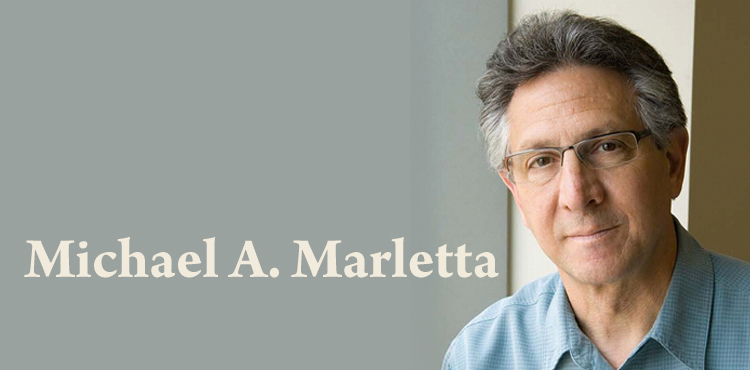
Michael A. Marletta
President-Elect, Cecil H. and Ida M. Green
Professor of Chemistry, The Scripps Research Institute, USA
Nitric Oxide Synthases in Prokaryotes: Characterization and Function
Since the discovery of nitric oxide (NO) formation in animals, it has become clear that this toxic, free radical, diatomic gas plays a central role in cellular function. NO is a signaling agent in the cardiovascular system and other tissues. The immune system also utilizes NO in the host response to infection. NO in signaling is synthesized by constitutive isoforms of enzyme nitric oxide synthase (NOS) that tightly regulate NO formation, thereby avoiding toxicity. Immune system-derived NO is made by inducible isoforms of NOS that are unregulated and hence, synthesize locally high concentrations. NOS catalyzes the conversion of L-arginine to citrulline and NO utilizing NADPH as a co-substrate. NOSs contain two flavins (FAD and FMN) to facilitate electron transfer from NAPDH to a cytochrome P-450 type heme positioned within the catalytic site. The redox active cofactor tetrahydrobiopterin (H4B) is also located in the catalytic site and undergoes a reversible one-electron transformation during catalysis. NOS-like proteins have recently been found in prokaryotes. In some cases these putative NOSs are found in organisms lacking the ability to synthesize H4B, calling into question if they, in fact, make NO. Some prokaryotic NOSs lack a reductase flavin domain and some of the full-length ones have replaced FMN with a 2Fe2S cluster (Figure 1). The chemistry catalyzed by these NOS-like proteins and the function resulting from that catalysis is under study and clues are beginning to emerge. The structure/function picture that is emerging points to some common themes though many questions remain.Michael A. Marletta was born in Rochester, New York, in 1951. After completing an A.B. at the State University of New York (SUNY), Fredonia (1973), a Ph.D. from UC San Francisco (1978) with George L. Kenyon, and a postdoctoral fellowship at the Massachusetts Institute of Technology (MIT 1978-1980) with Christopher T. Walsh, he joined the chemistry faculty at MIT in 1980. In 1987, he moved to the University of Michigan as Associate Professor in the College of Pharmacy and Medical School. In 1991, he was promoted to Professor and appointed the John G. Searle Professor of Medicinal Chemistry. In 1997, he was named to the Howard Hughes Medical Institute (HHMI). In 2001, Dr. Marletta moved to UC Berkeley, where he had been Aldo DeBenedictis Distinguished Professor of Chemistry (2002-2011) and Chair of the Department of Chemistry (2005-2011). Dr. Marletta is presently President-elect and Cecil H. and Ida M. Green Professor of Chemistry at the Scripps Research Institute.
Dr. Marletta is the recipient of dozens of awards and honors, including the MacArthur Foundation Fellowship (1995); Burroughs Wellcome Fund George H. Hitchings Award for Innovative Methods in Drug Discovery and Design (1991); Faculty Recognition Award at the University of Michigan (1992); the Harrison Howe Award of the American Chemical Society (2004); the Repligen Award of the Biological Chemistry Division of the American Chemical Society (2007); Kaiser Award from the Protein Society (2007); the Esselen Award for Chemistry in the Public Interest from the Northeastern Section of the American Chemical Society (2007); the Murray Goodman Memorial Prize (2008); and election to Senior Fellow in the Michigan Society of Fellows (1996), the Institute of Medicine (1999), the American Association for the Advancement of Sciences (2001), the American Academy of Arts and Sciences (2001), the National Academy of Sciences (2006).
Dr. Marletta's primary research interests lie at the interface of chemistry and biology with emphasis on the study of protein function and enzyme reaction mechanisms. He has made fundamental discoveries concerning the biological action of nitric oxide. His studies have provided the basis for understanding at the molecular level of this unique cell signaling pathway and the function of nitric oxide in the immune system. He has uncovered several novel structure/function relationships in nitric oxide synthase and guanylate cyclase. His continued studies on NO signaling have recently led to a molecular understanding of general gas sensing mechanisms in biology.

